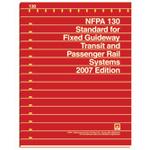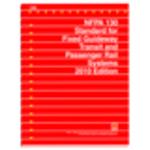
NFPA (Fire) 130
Product Details
- Published:
- 08/12/2022
- ANSI:
- ANSI Approved
- Number of Pages:
- 85
- Note:
- This product is unavailable in Ukraine, Russia, Belarus


Click here to purchase
NFPA 130 shall cover life safety from fire and fire protection requirements for fixed guideway transit and passenger rail systems, including, but not limited to, stations, trainways, emergency ventilation systems, vehicles, emergency procedures, communications, and control systems.
Vehicle maintenance facilities are not addressed by this standard because requirements for that occupancy are provided in other codes and standards. Where vehicle maintenance facilities are integrated or co-located with occupancies covered by this standard, special considerations beyond this standard shall be necessary.
Fixed guideway transit and passenger rail stations shall pertain to stations accommodating only passengers and employees of the fixed guideway transit and passenger rail systems and incidental occupancies in the stations. This standard establishes minimum requirements for each of the identified subsystems.
This standard shall not cover requirements for the following:
A shelter stop is a location along a fixed guideway transit or passenger rail system for the loading and unloading of passengers that is located in a public way and is designed for unrestricted movement of passengers. A shelter stop can have a cover but no walls or barriers that would restrict passenger movement.
To the extent that a system, including those listed in 1.1.3(1) through 1.1.3(6), introduces hazards of a nature similar to those addressed herein, this standard shall be permitted to be used as a guide.

Click here to purchase
Help ensure fire protection and life safety in mass transit systems. Apply the 2017 edition of NFPA 130: Standard for Fixed Guideway Transit and Passenger Rail Systems.
Originally developed to help reduce the potential for entrapment and injury of large numbers of people who routinely use mass transportation facilities, NFPA 130 specifies the latest fire protection and life safety requirements for underground, surface, and elevated fixed guideway transit and passenger rail systems.
It’s now more important than ever before for station and company managers, supervisors, safety personnel, inspectors, and AHJs to be aware of the latest NFPA 130 provisions for:
NFPA 130 requires users to apply NFPA 101®: Life Safety Code® and NFPA 72®: National Fire Alarm and Signaling Code with important modifications. Changes in this edition include:
NFPA 130 pertains to stations accommodating only passengers and employees of the fixed guideway transit and passenger rail systems and incidental occupancies in the stations.

Click here to purchase
NFPA 130 specifies fire-protection and life-safety requirements for underground, surface, and elevated fixed guideway transit and passenger rail systems, including:
Updated information for various definitions, interior finish requirements, and flammable/combustible liquids intrusionNFPA 130 pertains to stations accommodating only passengers and employees of the fixed guideway transit and passenger rail systems and incidental occupancies in the stations.

Get the inside track on safety for rail systems in NFPA 130!
NFPA 130 specifies fire protection and life safety requirements for underground, surface, and elevated fixed guideway transit and passenger rail systems including stations, trainways, vehicles, vehicle maintenance and storage areas.
Keep up with revisions in the 2007 edition that increase safety including:
This document pertains to stations accommodating only passengers and employees of the fixed guideway transit and passenger rail systems and incidental occupancies in the stations.

Click here to purchase
NFPA 130: Standard for Fixed Guideway Transit and Passenger Rail Systems specifies fire protection and life safety requirements for underground, surface, and elevated fixed guideway transit and passenger rail systems including stations, trainways, emergency ventilation systems, vehicles, emergency procedures, and communications and control systems.